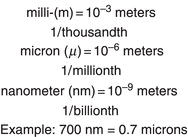2
Laser physics
Laser energy is made up of small particles known as photons, which move in waves. Ordinary light as we know it has multiple waves; it is also nondirectional and nonfocused.
All lasers are monochromatic, collimated, and coherent. They are one color, and the light is invisible to the naked eye because the laser operates outside of the visible range of the eye. Lasers are highly focused, unidirectional, and efficient; all of which makes them such a dependable tool in dentistry. The aiming beam light, which is in the visible portion of the electromagnetic (EM) spectrum, and its active medium is helium neon (HeNe). This component is added to most lasers so clinicians can visualize where the beam is directed, and the beam can be red, green, or blue.
Wavelength, which is important to the understanding of lasers, is the distance between any two corresponding points on the wave. Each wavelength has some of the same attributes, including velocity, which is the speed of light (186,000 mi/sec), and amplitude, which is the vertical movement of the total height of the wave from peak to peak. Velocity is measured in joules, which is a unit of energy and changes when watts are increased. The wavelength, itself, is the horizontal distance between the points of the wave, from crest to crest or valley to valley. In dentistry, wavelength is measured anywhere from 500 to 10 000 nm; a nanometer is one billionth of a meter.
Frequency is another important factor in working with lasers. It is relative to the number of complete oscillations per unit time of a wave and is measured in hertz, which are units of frequency in cycles per second. Common wavelengths measurements are listed in Figure 2.1.
Figure 2.1 Common wavelength measurements.

They include milli– (m), which is equal to 10–3 meters or 1/thousandth of a meter; micron (μ), which is equal to 10–6 meters or 1/millionth of a meter; and a nanometer (nm), which is equal to 10–9 meters or 1/billionth of a meter.
An example of these conversions is sometimes dependent on what laser is being used. Some lasers operate in nanometers and some operate in microns. It is important to know how to convert between these two or at the least know when they are equal. For example, 700 nm would be 0.7 microns. The change is made by moving the decimal point to the left.
Lasers operate in the EM radiation spectrum and are classified into types according to the frequency of the wave. These types include—in order of increasing frequency—radio waves, microwaves, infrared radiation, visible light, ultraviolet radiation, X-rays, and gamma rays. The behavior of EM radiation depends on its wavelength; this type of radiation is ionizing, which can cause mutagenic DNA changes. Types of this type of radiation are gamma, ultraviolet, and X-rays, which can also be penetrated deeper into the body. Higher frequencies have shorter wavelengths, and lower frequencies have longer wavelengths and are known as thermal radiation. Thermal radiation has no known health related contraindications at this time and includes radio waves, microwaves, and infrared radiation. The soft-tissue lasers that have been discussed for periodontal procedures are near-infrared, invisible, thermal radiation lasers. As a note, the HeNe laser pointer, discussed previously, is in the visible portion of the EM spectrum.
There are three regions (or boundaries) that are relative to laser emission. They are:
- Ultraviolet (1–349 nm)
- Visible (350–750 nm)
- Infrared (750+ nm)
Soft-tissue diode laser wavelengths range from 810 to 1064 nm within the EM spectrum, and the ND:YAG has a wavelength of 1064 nm. Both of these lasers target melanin and hemoglobin, and to a lesser extent, water. A more detailed discussion of how lasers fit into this spectrum is reserved for another chapter.
LASER CLASSIFICATION
There are four different laser classifications, and they numbered as Classes 1, 2, 3, and 4. These classes are further divided into subclasses.
Class 1 lasers are considered to be safe and not able to produce eye damage or risk in the radiation levels when viewed with the naked eye. Class 1 M lasers can be potentially hazardous when viewed with cameras, video recorders, microscopes, or magnification loupes.
Class 2 lasers range in the visible spectrum from 350 to 750 nm. These lasers include laser pointers or the HeNe 633 nm built into the dental lasers that allow clinicians to see where they are navigating in the mouth. Its blinking nature protects humans from eye damage from this type of laser. Class 2 M lasers have the same characteristics as Class 2; however, they can be potentially hazardous when viewed with cameras, video recorders, microscopes, or magnification loupes.
Class 3 has two subclasses, Class 3R and 3B. When the eye is stable and focused with Class 3R lasers, there is potential hazard with direct or indirect reflection of the beam. Class 3B lasers also have the same dangerous potential, but they do not have a potential for a fire hazard as the Class 3R do.
Class 4 lasers are susceptible to many hazards and include: fire, skin, eye, reflection, plume radiation, and air contaminants (Laser Institute of America [LIA] 2007a). See Table 2.1.
LASER SAFETY
When Class 3B and 4 lasers are in use, a laser safety officer (LSO) should be on staff (Table 2.2). These LSOs are responsible for the laser in its totality and in ongoing education and certification wit regard to the lasers in use. Before purchasing a laser, check with the manufacturer the type of the laser and to get proper training for each model being bought.
According to the American National Standard Institute (ANSI), there are certain terms that should be understood to use a laser saf/>
Stay updated, free dental videos. Join our Telegram channel

VIDEdental - Online dental courses


